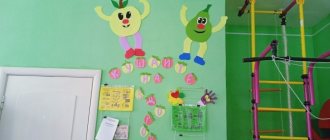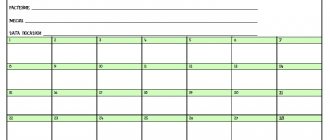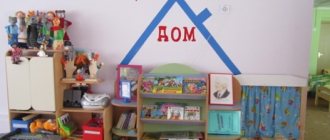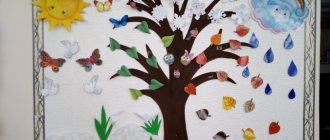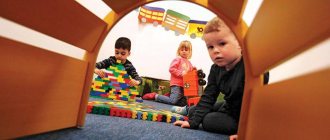Game room areas and their contents
As already mentioned, the playroom needs to be divided into play corners so that children can choose the activity they like. Each play area has its own educational functions and its own design. Next, we will consider the most common options for corners and their filling.
Construction games corner
needed to develop the child’s creative abilities and logical thinking. For this purpose, constructors are used that differ in material, shape, fastenings and sizes. In the best way, children will be given an idea of the weight and size of objects, and will be taught balance and orientation in space by large soft construction sets.
Corner of physical education and sports
will appeal to lovers of active physical activities. Sports equipment is placed here, with which you can independently practice various exercises. Soft sports modules that are easily transportable, multifunctional and safe will fit perfectly into the game room.
Corner of relaxation and privacy
- This is a place where children relax and gain strength. The corner can be either closed (a hut) or open, with comfortable frameless upholstered furniture. Poufs, pillows and pear chairs are also ideal for arranging a relaxation area, on which you can relax and lie down.
Active games corner
- a zone of complete freedom. Here children have the most opportunities to splash out energy through outdoor games. Various contour toys, dry pools and slides will help them with this.
Touch Corner
develops tactile perception. Children form ideas about the properties of objects and various phenomena by exploring them by touch. For this purpose, they choose didactic floor toys with various fasteners, locks, lacing, geometric shapes, etc. Such props perfectly develop fine motor skills and are used with pleasure by children in games. Also in the sensory corner, paths with different surfaces are desirable - ribbed, smooth, soft, slippery, hard, prickly, etc. Walking along paths is not only a fun activity for a child, which develops tactile sensations, improves the psycho-emotional state, but also a useful massage (prevents and treats flat feet, improves the sense of balance, etc.).
Corner "Road Rules"
needed to practice safe behavior on the roadway. The best way to do this is to use themed props (soft large cars, bibs with pictures) and role-play various situations with children.
Corner of role-playing games
Helps children develop imagination and communication skills. The setting of this zone should correspond to the game plot and the invented children's roles. Younger preschoolers, as a rule, give preference to plots based on the objects present; with their help, it is easier for them to get involved in plot-role-playing games. It is recommended to decorate the corner thematically. Ready-made corner options can be found among the so-called soft play sets.
Principles for designing a playroom in a preschool educational institution
1. Zoning
. It is necessary to divide the playroom into zones with different types of toys. This will avoid mixing gaming and educational processes.
2. Safety
. There should be no dangerous places in the room. You should stick soft corners on sharp corners, use plugs for heavy doors (stoppers), install limiters on windows for ventilation, purchase curtains for sockets, hide all wiring, and also pay attention to the floor - it should be smooth and warm.
3. Comfort
. Arranging a playroom begins with preparatory work. It is important to provide a suitable microclimate: temperature, humidity, lighting, fresh air flow. To monitor environmental indicators, it is better to install a weather station.
4. Saturation and variability
. The equipment of the game room should be varied and colorful. This will not only give children a choice, but will also decorate the room. It is desirable that the equipment provides all types of activity: motor (including fine and gross motor skills), cognitive, research, creative, joint. Also, do not forget to periodically update the game material.
5. Availability
. The playroom equipment should be located within the child’s reach so that he can use it independently at any time. Toys must be in good working order, appropriate for the age, and, if necessary, the limitations of the children.
6. Transformability and multifunctionality
. You will be able to use your budget rationally with equipment that is interesting to children of different ages and has various options for use. For example, soft modules are suitable for relay and building games, as well as for recreation. At the same time, both babies and older children (preschoolers) love them.
Interior design and architecture
All materials in the playroom, including construction materials, must have certificates confirming their origin, quality and health safety. Also, materials must be resistant to wet cleaning and disinfection. In accordance with these requirements, the following options are possible for the design elements and architecture of the game room:
1) floor, walls, ceiling
. According to the standards, the area of the playroom for early age groups (children under 3 years old) is determined at the rate of at least 2.5 × 2.0 m per child, for preschool age (children 3–7 years old) - at least 2 .0 × 2.0 m. The following floor coverings are allowed: linoleum, parquet, cork flooring, carpet. You can put, for example, a puzzle mat on top. To paint the walls, choose matte light colors: sand, turquoise, cream, coffee, light pink, lilac, etc. The walls can be decorated with children's images, vinyl stickers, paper applications, posters, etc. The ceiling can be either a regular whitewashed or painted, tiled and fabric stretched;
2) windows, lighting, furniture
. Curtains or blinds in light colors are required on the windows. Lighting (warm, perhaps with a yellowish tone) should be general and uniform, without open spotlights or harsh light. The sizes of drawers, cabinets, shelving and other furniture are selected according to the age of the children. In this case, the color of the furniture is allowed to be bright.
